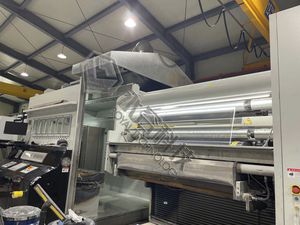
- Industrial machines and equipment
- Surface Treatment Equipment
- Film coating coating machine
- Shanghai Royal Technology Inc.
- Company
- Products
- Catalogs
- News & Trends
- Exhibitions
Roll-to-roll coating machine R2Rfor film coating






Add to favorites
Compare this product
Characteristics
- Options
- roll-to-roll, for film coating
Description
Aluminum oxide barrier coatings on polymer films for food packaging applications
Highlights
AlOx barrier coatings deposited via reactive thermal evaporation onto polymer films.
Effect of plasma treatment on barrier performance was investigated.
Uncoated films were characterized in terms of topography and surface energy.
Surface energy and adhesion of AlOx coating were determined.
AlOx barrier performance depends on surface characteristics of uncoated films.
Substrate materials
Various packaging grade BOPP films and a PET base film (all corona treated in-house by the film producers), as well as a BOPP film coextruded with a special high surface energy polymer as a skin layer were coated with an aluminum oxide barrier layer. The coatings were applied to the corona treated side of each film and the high surface energy polymer skin layer, respectively. All standard packaging grade BOPP films
Barrier properties of packaging grade PET and BOPP films, coated with aluminum oxide via reactive thermal evaporation, are strongly affected by the surface characteristics of the plain film, such as surface defects and surface chemistry. These parameters have a large impact onto the aluminum oxide coating nucleation, growth and structure and not only vary to a large extent between the different polymer film types, but can also change significantly within one substrate type, as has been shown
VIDEO
Other Shanghai Royal Technology Inc. products
Roll to Roll Web Vacuum Metallizer
Related Searches
- Coating machine
- PVD deposition machine
- Vacuum deposition machine
- Thin-film deposition machine
- Metalized film deposition machine
- Arc evaporation deposition machine
- Thermal evaporation deposition machine
- Deposition machine for the microelectronics industry
- Automotive deposition machine
- Short-cycle deposition machine
- CVD deposition machine
- Glass coating deposition machine
- Ion beam-assisted deposition machine
- Online deposition machine
- Deposition machine for photovoltaic applications
- Deposition machine with rotating cathodes
- PECVD deposition machine
- Medical deposition machine
- Sputtering coating machine
- Laboratory coating machine
*Prices are pre-tax. They exclude delivery charges and customs duties and do not include additional charges for installation or activation options. Prices are indicative only and may vary by country, with changes to the cost of raw materials and exchange rates.












